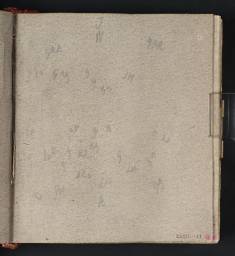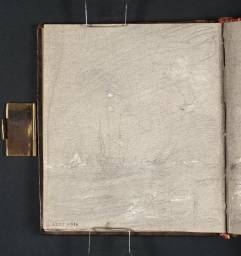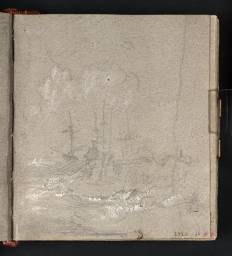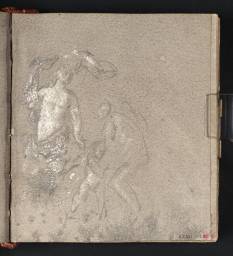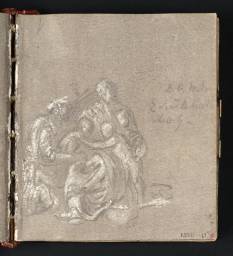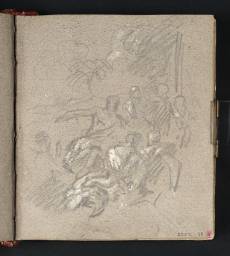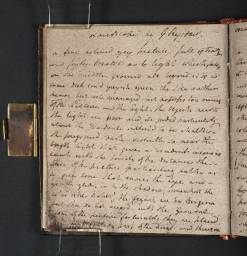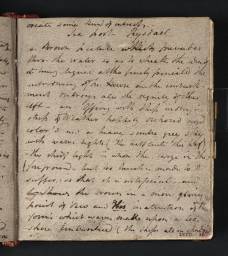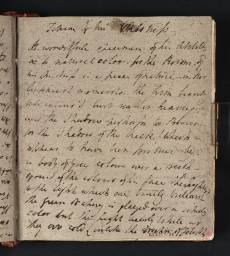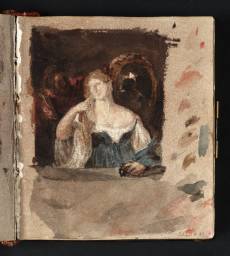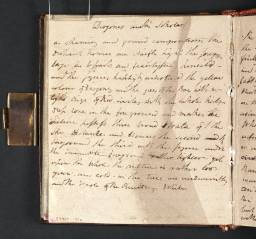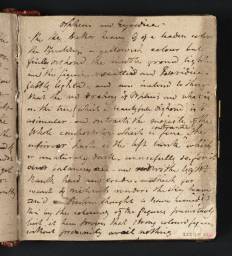Turner Bequest LXXII
Sketchbook bound in calf, with gold-tooled edges and spine, and brass clasp
87 leaves of white wove Hayes & Wise writing paper, made on a double-faced mould, and one (folio 61) of white wove Whatman drawing paper, made on a double-faced mould, prepared with a variety of grey and reddish washes; with endpapers of unidentified cream wove paper, made on a double-faced mould
Approximate page size 128 x 114 mm
Made up by William Dickie. Some leaves of the paper by John Hayes and John Wise of Padsole Mill, Maidstone, Kent, show parts of the watermark ‘HAYES & WISE | 1799’. The leaf of Whatman paper, made by William Balston and Finch and Thomas Robert Hollingworth, Turkey Mill, also at Maidstone, watermarked ‘1794 | J WHATMAN’. The endpapers, maker unknown, watermarked ‘1799’
Numbered ‘310’ as part of the Turner Schedule, and endorsed by the Executors of the Turner Bequest, Henry Scott Trimmer and Charles Turner in ink, ‘Contains leaves in pencil and colour | H.S Trimmer | C. Turner’, and initialled by Charles Lock Eastlake and John Prescott Knight in pencil, ‘C.L.E.’ and ‘J.P.K.’ inside front cover
87 leaves of white wove Hayes & Wise writing paper, made on a double-faced mould, and one (folio 61) of white wove Whatman drawing paper, made on a double-faced mould, prepared with a variety of grey and reddish washes; with endpapers of unidentified cream wove paper, made on a double-faced mould
Approximate page size 128 x 114 mm
Made up by William Dickie. Some leaves of the paper by John Hayes and John Wise of Padsole Mill, Maidstone, Kent, show parts of the watermark ‘HAYES & WISE | 1799’. The leaf of Whatman paper, made by William Balston and Finch and Thomas Robert Hollingworth, Turkey Mill, also at Maidstone, watermarked ‘1794 | J WHATMAN’. The endpapers, maker unknown, watermarked ‘1799’
Numbered ‘310’ as part of the Turner Schedule, and endorsed by the Executors of the Turner Bequest, Henry Scott Trimmer and Charles Turner in ink, ‘Contains leaves in pencil and colour | H.S Trimmer | C. Turner’, and initialled by Charles Lock Eastlake and John Prescott Knight in pencil, ‘C.L.E.’ and ‘J.P.K.’ inside front cover
Exhibition history
References
This sketchbook was used in Paris during Turner’s first continental tour in 1802 (see Introduction, Sketchbooks from the Tour to Switzerland 1802). He brought it with him from England, and used it for studies and notes on pictures he saw, all but one or two of them being in the Louvre.
That Turner should have this opportunity was the main object of the consortium of noble patrons who funded his trip across the Channel in 1802. Turner would later describe the experience as ‘no small wonder’.1 He was in Paris twice that year, around 18–26 July and again for approximately three weeks from late September into October, on his return from the alpine tour that had been his own priority. A copy after Pier Francesco Mola in the France, Savoy, Piedmont sketchbook (Tate D04394; Turner Bequest LXXIII 2) and notes on two pictures by Titian and Correggio in the Small Calais Pier sketchbook (Tate D04262, D04264; Turner Bequest LXXI 62a, 63a) may have been made on the first visit. However, the majority of his drawings and commentaries, and the most elaborate, were made in this book which he must have reserved for his longer stay. Its leaves had been prepared before binding with washes ranging from light grey to deep reddish-brown, to provide suitable grounds for coloured drawings. Turner may have intended to show his copies and notes to the patrons who had sponsored his visit to the Louvre.
No comparable public collection then existed in London, while the Louvre was entering a period of exceptional if short-lived splendour. Pictures from the French royal collection, along with antiquities, had been displayed to the public at the Louvre since the early seventeenth century, but the Revolution gave impetus to the concept of the palace as a museum, new displays being opened in 1793. The trophies of French conquests – pictures and antiquities from Italy, notably from the collections of the Vatican in Rome and the Grand Dukes of Tuscany in Florence, from Modena and Venice, and of more pictures from Germany and the Netherlands – had since greatly enriched the holdings of the so-called Musée Central des Arts. 1802 saw the appointment of the Louvre’s first director, Dominique-Vivant Denon, whose idea it was to christen it the ‘Musée Napoléon’ and transform it into an encyclopaedic treasury of world art by selective confiscation during his master’s campaigns. Already extraordinary in 1802, the collection would continue to grow throughout the decade, until the fall of Napoleon in 1815 brought about the repatriation of many of Denon’s most prized acquisitions. The diary of Turner’s colleague Joseph Farington provides the fullest written account of its effects on its British visitors in 1802. Farington recorded the remark of the Whig politician Charles James Fox, ‘alluding to what [is] made by War, “What is an Island to such a Collection?”’.2 While Farington lamented the removal of many great works, particularly those on Christian themes, from their context to something akin to ‘the promiscuous arrangement of an Auction room’ in which their spiritual message was diminished, he acknowledged that ‘to the Painter, to him who has to learn the principles upon which the Great Masters of his Art worked, the Gallery at Paris is the place where He may pass his hours in careful consideration and deep reflection’, and ‘learn to think soberly, and rationally of the nature of his Art’.3 Another painter, John Opie, told him ‘an Artist who could not be moved by what is in the Gallery in Paris would go further in vain’.4
As far as pictures were concerned, the glory of the Louvre, in 1802 as today, was the Grande Galerie. It was there that Farington encountered Turner on 30 September, two or three days after his return from Switzerland, and again on 5 October when he found him ‘drawing’.5 The gallery was first built by Henri IV along the riverside front of the Louvre to join it to the Tuileries. In 1794 its immense length – nearly 500 metres – had been divided by free-standing marble columns surmounted by antique busts, to create enclaves for groups of pictures. Otherwise the gallery remained plain, unadorned and gloomy, though containing an increasingly spectacular array of masterpieces. During the following decade, improvements were made, first by the architect Jean-Armand Raymond, who during 1802 installed an experimental scheme of top- lighting in part of the gallery, and from 1805 by the firm of architects and decorators Percier and Fontaine, who transformed it by fixed columns and arches and extended the roof-lighting, creating the scheme familiar – with some further modifications – today. Turner sketched Percier and Fontaine’s sumptuous décor on his return to Paris in 1821 (Tate D24924, D24961; Turner Bequest CCLX 88, 125). A good impression of what he saw in 1802 can be gained from Hubert Robert’s picture, The Grande Galerie Looking West, painted that year or the next (Louvre). This shows a section devoted to the Italian schools, with the pictures densely hung, the smallest at the lowest level and others two or three deep or grouped around the largest works. Most of the pictures Turner studied were hanging here, having been moved in 1801 from the Salon carré at the eastern end of the gallery. Long the home of the Salon, the annual exhibition of living artists, this great room, the creation of Louis XIV, had also been used since 1793 for the first displays of plundered works before they were integrated into the wider collection. Its own alternating hangs and periodic dispersals of works were a challenge to the curators, somewhat qualifying their ambitions for the Grande Galerie as a stable arrangement of masterpieces grouped according to school.
It is not possible to know exactly what Turner saw where, or how precisely the pictures were hung. From 1799 the Louvre had published Notices first of its French and Flemish pictures, then, in 1801, of the Italians to coincide with their installation in the Grande Galerie, but their orderly alphabetical and chronological listings could not properly reflect the hang. Maria Cosway’s ambitious scheme for an illustrated Galerie du Louvre, a collaboration between herself and the entrepreneur Julius Griffiths and containing her own illustrations of pictures arranged in groups on the walls, was begun in 1802 but left unfinished at the resumption of war the following year; moreover she allowed herself some artistic licence in the arrangement of her plates. Henry Fuseli, one of Farington’s travelling companions, never published the ‘critical account of the pictures and statues in the Louvre’ which was the original purpose of his visit.6 Especially to be regretted, since they would have coincided with Turner’s visits, is the loss of the outline diagrams of the hang prepared by Farington himself; he records finishing that of one side wall, and beginning the other, on 5 October, the last day he met Turner in the gallery. As it stands, Farington’s diary indicates that the hangs were in their characteristic state of flux. On 1 September, for example, he had noted that Titian’s St Peter Martyr, which Turner commented on (folios 28 verso–27 verso, D04308–D04306), and Raphael’s Transfiguration, of which he made a colour key (folio 13, D04287), had along with other works only just been taken down from the Salon carré to make way for the Salon, due to open the next day, and were ‘placed in an unfinished continuation of the Gallery ... on the ground’;7 on 18 September he discovered another work copied by Turner (folio 25, D04301), the so-called ‘Titian’s Mistress’, brought into the Grande Galerie with ‘many others which had not been placed there before’.8 Some of these movements were doubtless caused by work on the top-lighting in progress that year, but now also, the Louvre was beginning to feel the impact of Denon’s organisational and curatorial skills.
The pictures drawn or commented upon by Turner remain in the Louvre unless otherwise stated. All are by Old Masters save for one contemporary picture, The Return of Marcus Sextus by Pierre-Narcisse Guérin, which, having been shown at the Salon of 1799 was not in the Louvre but at the premises of its then owner in the Place des Victoires (folio 47 verso, D04334). Turner noted the names of French contemporaries and visited several including Jacques-Louis David, but like most of his London colleagues in Paris that year, thought little of their work;9 Guérin’s picture was approved because it seemed untypical of the current French school, and that it was so greatly admired by French artists caused surprise. In choosing Old Masters for comment and study, Turner concentrated on the Venetians and above all Titian among the Italians. He had not been among the many London artists duped by Ann Provis’s bogus rediscovery during the 1790s of the ‘Venetian Secret’ of painting technique,10 but he was nevertheless as interested as his colleagues in the colouristic qualities of the Venetian school.11 Among the Louvre’s plundered pictures, Correggio’s St Jerome from Parma was hardly less revered than the St Peter Martyr, and Turner gave it due attention (folio 64, D04358). Until now it has been thought that he ignored an equally famous picture, Raphael’s Transfiguration brought from the Vatican, but while he certainly did not draw it, he did make the colour key noted above. In addition, he extended his reach to the Roman and Bolognese Baroque and works by or attributed to Domenichino. The Mannerism of the expatriate School of Fontainebleau caught his eye in the form of a composition by Francesco Primaticcio, seen either in a drawing then on show in a display of drawings in the Louvre’s Galerie d’Apollon or (if Turner visited Fontainebleau itself) the ceiling fresco in the Porte Dorée of the palace (folio 88 verso, D04388).
Among French artists, Turner paid close attention to Nicolas Poussin and some to his contemporary Charles Le Brun, but none to Claude Lorrain. Along with these masters of French classicism, Dutch and Flemish painting had been richly represented in the collection since the reign of Louis XIV and Louis XVI had added important examples in the twilight years of the ancien régime. Interest in the naturalistic qualities of Netherlandish painters had been spurred in England by the recent dispersals of the Orléans and other collections in London after the Revolution. In Paris Turner focused on artists like Ruisdael and Rembrandt whose subjects and style might inform his own, and was more critical of Rubens whom he admired rather in spite of himself. In the case of Ruisdael, he was on the lookout for any failures in treatment of marine themes like those in his own recent pictures, having perhaps got wind of adverse comparisons made by his colleagues.
His viewing was presumably conditioned by his Academy education, taste and expectation, and modified by the conditions of the Paris hang and the need to make the best possible use of his limited time with the requirements of his own art in mind. A further factor seems to have been the current state of attribution, whether the Louvre’s or his own. He copied works then but no longer given to Rembrandt, but speaking of Claude’s pictures in a lecture of 1811, claimed that ‘The walls of the Louvre can only boast of two by name, which two may with more propriety be [Herman] Swanevelt’.12 This cannot wholly account for his omission of Claude, however, since seven of the master’s pictures were probably hanging in the Grande Galerie in 1802 and he copied some of them in 1821. Instead, Turner’s indifference has been variously explained by their being hung in 1802 in such shadow as to be nearly invisible, and by the fact that he had already had plentiful opportunity to study works by the artist in London and elsewhere at home. The second point, however, might equally be made of Titian or Poussin, to whose works in the collections of the Duke of Bridgewater or the Earl of Ashburnham he compared the Louvre’s examples in his notes. And it is also arguable that Claude had yet to emerge as a primary source of inspiration.
In studying the pictures, Turner was not consistent in his methods. He must soon have realised that it was too time-consuming always to copy in colour. In any case, colour or further elaborations may sometimes have been added later to more perfunctory sketches made on the spot, accounting for deviations from the original pictures. Some drawings are in pencil or chalks, or record pictures mainly in terms of light and shade. Other pictures Turner addressed only through systems of colour notation, setting out their colours by patterns of initials or numbers which read like notes on a musical score. Unfortunately these are difficult or impossible to decipher; Turner’s code is not completely known and he did not always name the pictures he recorded in this way. On a number of pictures – not necessarily those he copied – Turner also wrote commentaries. That these too so often focus on questions of colour ensured that among the first to give them extensive critical discussion was John Gage, who expressed surprise that Turner had not entered into such detailed analyses of the Old Masters before, despite being already familiar with some distinguished collections at home and having copied works in them. Gage noted that Turner’s Louvre notes are ‘remarkably complex and assured’, while being characteristic of the taste of their period in the opinions expressed and in his choice of artists and works.13
Michael Kitson has shown how Turner’s remarks on Poussin take their cue from Joshua Reynolds’s Academy Discourses (1769–90), but progress to a ‘new and significant Romantic criticism’ of the painter in their appreciation of his ‘sublime’ and ‘natural’ colour.14 Romantic too is the suspicion of rules that Turner drew from his study of Poussin, who struck him as a painter who developed his colouring instinctively as a vehicle for his ideas and to cast the mind back into antiquity rather than according to system. Fascinated as he clearly was by Poussin as a colourist, and interested in the architectonic structure of his compositions, he was highly critical of the formal content of a picture like the Louvre’s famous Deluge. As concerned with the subsequent condition history of pictures as with how they might first have been painted, he believed that some of the most striking colouristic effects he saw – the bright blue sky of the St Peter Martyr or Poussin’s harder reds and blues – were the result of later alterations. The first idea can no longer be tested and the second was evidently wrong, but he certainly knew of the pioneering work being done by the Louvre’s restorers on Raphael’s Transfiguration.
Turner’s remarks in the sketchbook are as often conceptual and emotional as they are technical and descriptive. While he devoted much time to method and process, whether in written analyses or in the initial colour charts he jotted down for some pictures, he could also engage with the narrative dynamics and psychological dramas of Titian’s Entombment or Christ Crowned with Thorns with such insight that he was, for once, able to overcome his customary awkwardness with words and achieve an almost lyrical prose (folio 31 verso, D04314; folio 51 verso, D04399). How ‘historical’ and naturalistic colour could be reconciled to harmonise the sentiment of a picture was perhaps his overriding concern. Consistently, he focused on masters of emotive colour and expressive handling, and he was keenly aware of the irony that so many of their pictures had come into the possession of a nation whose own painters then seemed set on an opposite course. He was dismissive both of the French style and of French ability to appreciate the works they had taken. The issue crystallised in reactions (folio 33, D04316) to Van Dyck’s portrait, Cardinal Guido Bentivoglio, brought from Florence, as well as to Titian. As Turner later wrote: ‘They who have returned with all the exquisite productions of ransacked countries look with cool indifference on all the matchless power of Titian’s glowing tones because precision of detail is their sole idol’.15
Turner quoted by Barry Venning, ‘Turner’s Annotated Books: Opie’s “Lectures on painting” and Shee’s “Elements of Art”’ (II), Turner Studies, vol.2, no.2, ‘1983’ for 1982, p.45.
Kenneth Garlick and Angus Macintyre eds., The Diary of Joseph Farington, vol.V, New Haven and London 1979, p.1819 (1 September 1802).
For the ‘Venetian Secret’ see John Gage, Colour and Meaning: Art, Science and Symbolism, London 1999, pp.153–61.
Technical notes
How to cite
David Blayney Brown, ‘Studies in the Louvre sketchbook 1802’, sketchbook, October 2009, in David Blayney Brown (ed.), J.M.W. Turner: Sketchbooks, Drawings and Watercolours, Tate Research Publication, December 2012, https://www

